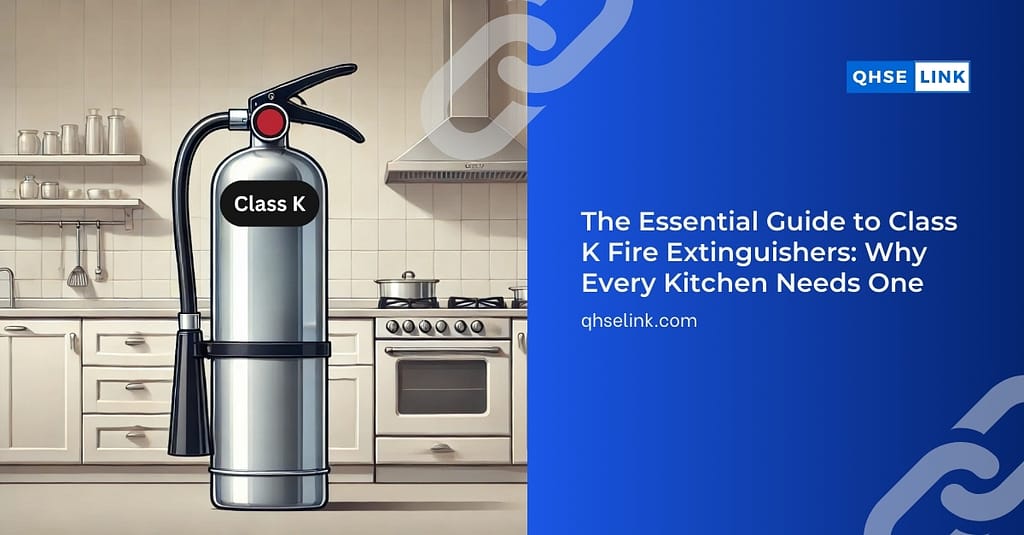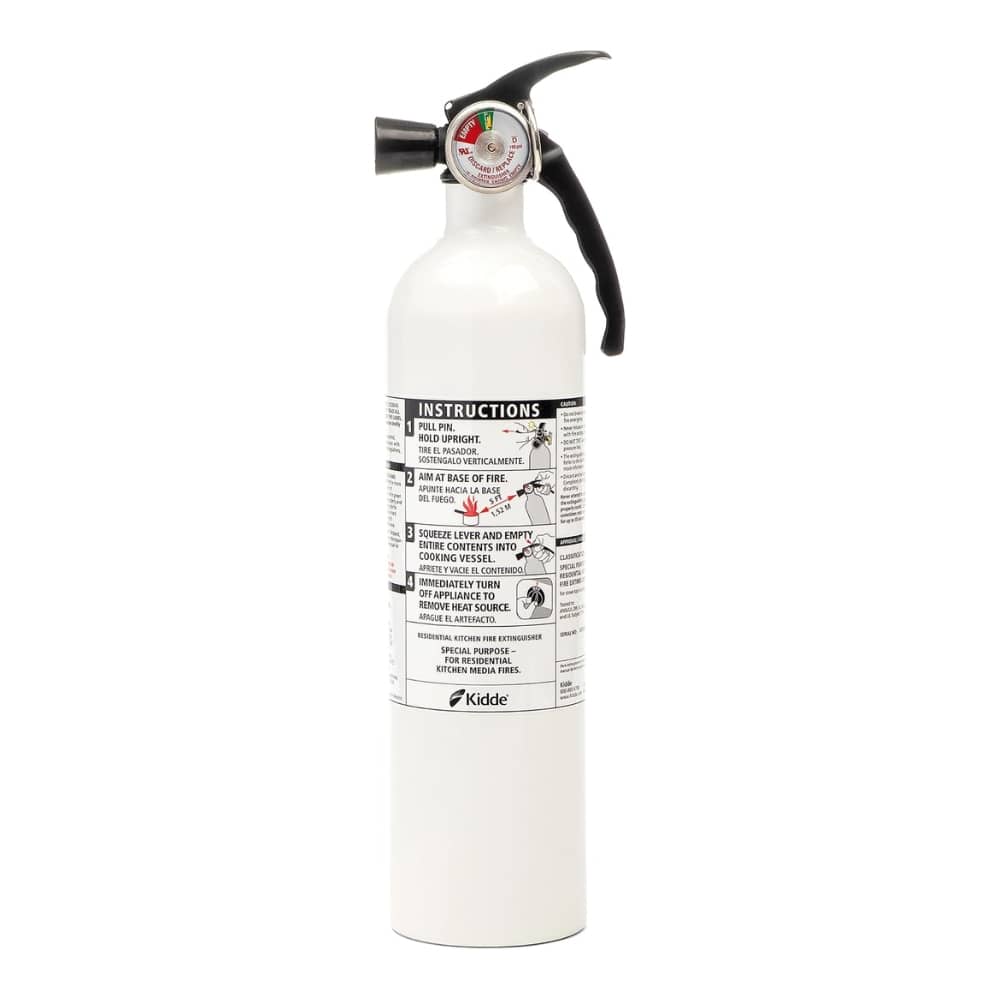When it comes to fire safety, not all fires are created equal—and neither are fire extinguishers. If you’re in a commercial kitchen or even a large-scale home kitchen that frequently handles oils and fats, you need a specialized tool to handle potential hazards. Enter the Class K fire extinguisher.
Specifically designed for kitchen fires caused by cooking oils and fats, Class K extinguishers are tailored to extinguish grease fires that are extremely dangerous and notoriously hard to put out. In this guide, we’ll unpack what makes Class K extinguishers unique, how they work, and why they’re a critical safety measure for kitchens everywhere.

What Is a Class K Fire Extinguisher?
A Class K fire extinguisher is a specialized firefighting tool designed to combat high-temperature grease, fat, and oil fires. These fires, typically found in commercial kitchens, occur when oils or fats reach their flashpoint and ignite. Traditional extinguishers (like Class A, B, or C) may struggle to suppress these fires effectively, which is where Class K extinguishers shine.
Class K extinguishers use a wet chemical agent—usually a mix of potassium acetate or potassium carbonate—that works by creating a thick foam-like layer over the burning oil. This process, called saponification, cools the fire and removes the oxygen, effectively smothering it.
Why You Need a Class K Fire Extinguisher
Commercial kitchens are filled with fire hazards: deep fryers, grills, ovens, and stovetops are all potential sources of grease fires. Here’s why having a Class K fire extinguisher on hand is essential:
- Designed for High-Temperature Grease Fires: Regular extinguishers may scatter grease, making the fire worse. Class K extinguishers are specifically engineered to safely and effectively put out grease fires.
- Compliance with Safety Regulations: Many jurisdictions require commercial kitchens to have Class K extinguishers as part of their fire safety standards.
- Quick Response to Emergencies: A fast-acting extinguisher can mean the difference between a minor incident and a catastrophic fire.
- Protecting Lives and Property: Fires caused by oils and fats spread rapidly, putting both people and property at risk. Having the right extinguisher can save lives.
How Does a Class K Fire Extinguisher Work?
The magic of a Class K fire extinguisher lies in its wet chemical agent. Here’s how it works:
- Saponification Process: When the wet chemical is sprayed onto a grease fire, it reacts with the fats and oils to form a soapy foam.
- Cooling Effect: The foam lowers the temperature of the fire, reducing the chance of re-ignition.
- Oxygen Deprivation: The foam creates a barrier between the oxygen and the fuel, effectively smothering the fire.
This process is highly effective for kitchen fires but isn’t suitable for other types of fires, like electrical or paper fires. That’s why it’s essential to pair your Class K extinguisher with other types of extinguishers for comprehensive fire safety.
Where Should You Use a Class K Fire Extinguisher?
Class K fire extinguishers are specifically designed for use in environments where cooking oils and grease are present. Common places you’ll find these extinguishers include:
- Restaurants and Cafes: Especially in kitchens with deep fryers and stovetops.
- Catering Facilities: Large-scale cooking operations with high fire risks.
- Food Trucks: Tight spaces with cooking appliances make these extinguishers essential.
- Home Kitchens (in some cases): If you frequently deep-fry or cook with oils, a Class K extinguisher might be a good investment.
Features to Look for in a Class K Fire Extinguisher
When shopping for a Class K extinguisher, keep an eye out for these key features:
- UL Rating: Make sure it’s certified for Class K fires.
- Size and Capacity: Depending on your kitchen size, choose an extinguisher that can handle your needs.
- Ease of Use: Look for a model with clear instructions and a user-friendly design.
- Rechargeable vs. Disposable: Rechargeable models can save money in the long run but require maintenance.
Kidde Kitchen Fire Extinguisher

How to Use a Class K Fire Extinguisher
Using a Class K extinguisher is straightforward, but it’s crucial to follow proper protocol:
- Pull the Pin: This unlocks the extinguisher.
- Aim Low: Point the nozzle at the base of the fire, not the flames.
- Squeeze the Handle: Release the wet chemical agent.
- Sweep Side to Side: Cover the entire area of the fire until it’s completely extinguished.
Remember, safety first! Always evacuate the area and call 911 if the fire is uncontrollable.
Maintenance Tips
To ensure your extinguisher is ready when you need it, follow these maintenance tips:
- Regular Inspections: Check the pressure gauge monthly to ensure it’s in the green zone.
- Annual Professional Servicing: Many local fire departments or certified technicians can inspect and maintain your extinguisher.
- Replace or Recharge After Use: Even if you use a small amount, the extinguisher needs to be recharged or replaced.
FAQs
Can I use a Class K extinguisher on electrical fires?
No, Class K extinguishers are specifically designed for grease fires. Use a Class C extinguisher for electrical fires.
Are Class K extinguishers mandatory in commercial kitchens?
In most jurisdictions, yes. Check your local fire codes to ensure compliance.
Can I use a Class K extinguisher in a home kitchen?
Yes, but they are more commonly used in commercial settings. If you frequently cook with large amounts of oil, it’s worth considering.
What’s the lifespan of a Class K fire extinguisher?
Most extinguishers last 5–15 years, but regular maintenance is key to ensuring they work when needed.
Final Thoughts
A Class K fire extinguisher is more than just a tool—it’s a lifesaver for commercial kitchens and high-risk cooking environments. By understanding how these extinguishers work and keeping one on hand, you’re taking a proactive step toward protecting your team, your property, and your customers.
Don’t wait until it’s too late! Make sure your kitchen is equipped with a Class K fire extinguisher and keep it properly maintained. After all, when it comes to fire safety, an ounce of prevention is worth a pound of cure.
For more information about fire safety equipment or to explore other fire extinguisher types, check out this helpful guide from NFPA.